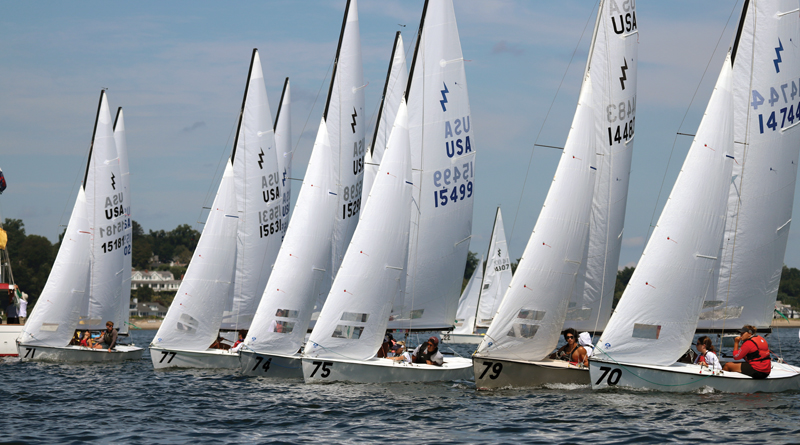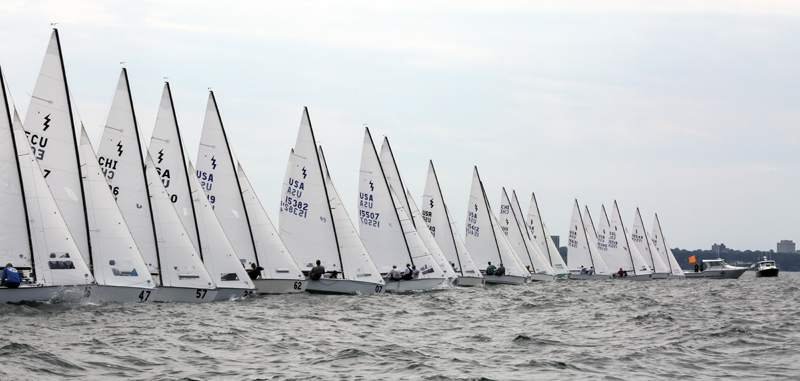Starting well is hard.
In sailboat racing, the lure of the “perfect start” is beguiling. Don’t you just want to magically start at the favored end of the line and jump out to a two-boat length lead every single race? I hate to break it to you, but it’s not gonna happen, at least not every race.

Take a deep breath. It’s going to be okay! The process of learning how to start well and improving your skills can be frustrating and never ending. But with some work and focus, you can accomplish starts that are good enough to get you going where you need to go: Off the line, at full speed, heading in the direction you want to go with fairly clean air. Here are three areas where you can practice your skills to help you achieve solid starts.
Time and distance to the line.
Imagine a starting line. You’re the only boat around. You get to start exactly when you want and going as fast as you want. (You’re not allowed to be OCS!) Of course, you’ll choose to have your bow just on the not-OCS side of the line and also going full speed right when the gun goes off. So, how can you achieve that in the real world? Knowing how long, both in time and distance, it takes you to accelerate to full speed is a critical element. When you know this information, you can back things up—maybe it takes eight seconds to accelerate to full speed, and you cover a boatlength and a half in the process. Ideally you’d be ready for your start, hanging a boatlength back from the line, and when you get to eight seconds to go in the countdown, you sheet in and go.
Of course, it’s never that simple in practice. The boats around you may linger too close to the line. Or there may be adverse current, so you need to hang closer to the line. Practicing that acceleration and timing gives you the tools you need. It’s great if you can get out from time to time for practice with a coach who can set up a short starting line, with the coach serving as the signal boat end. The coach gives you a countdown, and your goal is to be on the line, full speed, at “go”—and they can help you refine your approach. Another important drill you can do in this setup is the hand/whistle drill: As you approach the line, skipper (and crew; and you don’t have to have the same “answer”) raises their hand when they think their bow is on the line. The coach whistles when their bow is actually on the line. Sometimes hands are raised and whistles are blown simultaneously… and sometimes they’re not, providing great learning opportunities.

Acceleration.
Here’s where you get to focus on boathandling and being cognizant of the conditions you’re sailing in. The process for getting a boat up to speed differs greatly from class to class. Keelboats can require a lot of lead time (and distance) getting rolling before heading up to close-hauled, while some dinghies just need a quick sheet in and hike flat. Once you get accelerating in a happy eight to 10 knots with no waves or current, spice it up a bit by practicing accelerating when things are more complex. What’s the tradeoff for your boat when it gets windy—does the increased wind give you more “juice” to work with, or does the wind resistance from flogging sails hold you off the line? Things often slow down when the wind eases off, too.
Positioning.
This is where you get to put your time and distance work into practice as you head toward the line on final approach. If you’re in a suboptimal position, it’s hard to accelerate as you’re often in dirty air. Consider where you’re going to end up as you either tack in or approach from leeward to get into the lineup of boats luffing on starboard tack. Be sure the result of your approach will be with your bow in clean air, so that you end up not underneath other boats, struggling to get forward enough to get your bow out. Getting into a solid position at the right point in the final 30 seconds really lets you use your acceleration and speed when you need it most—and lets you better control your time and distance work.
Now for the really hard stuff—combining your time and distance savvy with acceleration practice and doing all that in a good position on the line. It’s not easy, but getting off the line at least reasonably well gives you the opportunity to succeed in the rest of the race.
by Kim Couranz
About the Author: SpinSheet Small Boat columnist for more than a dozen years, Kim Couranz has earned several national and world titles in Laser Radials (ILCA 6), Snipes, and Lightnings. She has also raced J/22s, J/24s, and Ynglings on an international level.




